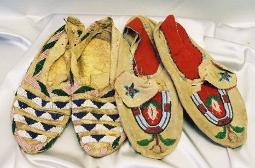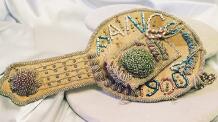
Cherokee Indian Art: Beadwork and Basketry Faced with continuing loss of their lands and the decline of hunting and fishing in the 19th century, the Cherokee Indian Tribe and their relatives, the Iroquois nations of New York State and Canada, came up with a successful survival strategy: they would sell tourists the fancy Indian beadwork, wood carvings, and beautiful baskets they had long done for themselves. Tourists loved their Indian designs. Cherokee Indian beadwork and basketry existed before recorded history when beads made from shells and bird bones were used instead of the tiny glass cylinders first brought to North America by European explorers in the 16th century. They used the teeth, bones, and claws of wild animals to decorate their clothing. Dried berries and gray Indian corn were also shaped into beads. Cherokee Native Americans made moccasins, bags, pincushions, needle cases, sport caps, picture frames, match holders, clothing and hanging baskets, which were brilliantly stitched with tiny glass beads by women, using tribal themes but also adapting to the Victorian tastes of their buyers. Early native Americans actually used wampum designs as "documents" for record keeping in the absence of a written Indian language. They used local shell, stone, bone, horn, and even Venetian glass beads, dating from the 1580's to the 1630's. This was called wampum. Records show that glass beads were first supplied to the Mohawks, one of the six Iroquois nations, as early as 1616, and by the 18th century commercial beads were in widespread use. Before that, quill work, using dyed porcupine quills, was a preferred form of decoration. The stiffness of the quills made them more suitable for geometric design. Abundant plant life in the Cherokee regions suggested the use of curvy forms with leaf and floral patterns in their beadwork and basketry designs. Significant tribal symbols relating to the Cherokee cosmology are also prevalent in their art works. Among them is the Sky Dome, a half circle resting on two parallel lines, with a pair of simplified plant forms springing from the dome's top. The dome signifies the arc of the sky, the parallel lines the earth. The plant forms represent the celestial tree of life that stands at the center of the Native American world, bearing the sun and the moon aloft in its branches. Symbols in Cherokee Indian Beadwork Symbols enhanced by elaborate scrollwork, was often used to adorn women's leggings. Other Native American tribal motifs include the sun in stylized form, the celestial tree as a floral Indian design with fruits, the mythological Native American turtle upon which the earth was built and other animal clan Indian figures. |
| Below: Cherokee Native American bead moccasins, 1910 |
| Below: Cherokee Indian beadwork reported to be woven by students in 1940 at the Cherokee Female Seminary in Park Hill, Oklahoma. |
| 1920 tobacco bag |
| Below: A Native American 1900 Cherokee vest with beadwork designs. |




| Above: Cherokee beaded pincushion, 1890 |
| The 18th century Indian bead shirt (top/right) is an example of the use of symbols. Notice the white Indian beads on the edges of the garment, and a lacy design of stylized flowers springing from tiny triangles with a row of beaded Indian curves simulating scalloping. Notice that even today, Cherokee beadwork has elements reflective of the Victorian influences of the 1800's. Their beading became fuller and more florid, creating an embossed, bas-relief effect and often covering most of the background. A wider color range brought in more dark and medium tones. Examples abound in the form of pouches and purses, pincushions, caps and such made for tourists. For instance, in late 1890, they began copying a European decorative art form used in creating the Tuscarora beaded handbag. It was and cut in a perky curvaceous shape, and covered with floral elements sophisticatedly worked in red, blue, white, yellow and other colors, the whole framed by a variety of neat white borders. Pincushions made to hold long hatpins and sewing needles were one of the most popular items sold by early beading fabric were one of their specialties. They would frequently use beads to form a six-pointed star embroidered in white beads with a black center containing a white eagle bearing an American flag on each wing. Headgear took the form of heavily beaded caps for sports, for smoking and for general use. Of the sports caps, reminiscent of the ubiquitous baseball toppers that men wear today except that they have shorter visors. They usually were heavily encrusted with gray floral beading on a dark gray ground. Many Photos Courtesy of Denver Museum Archive and Library of Congress |




